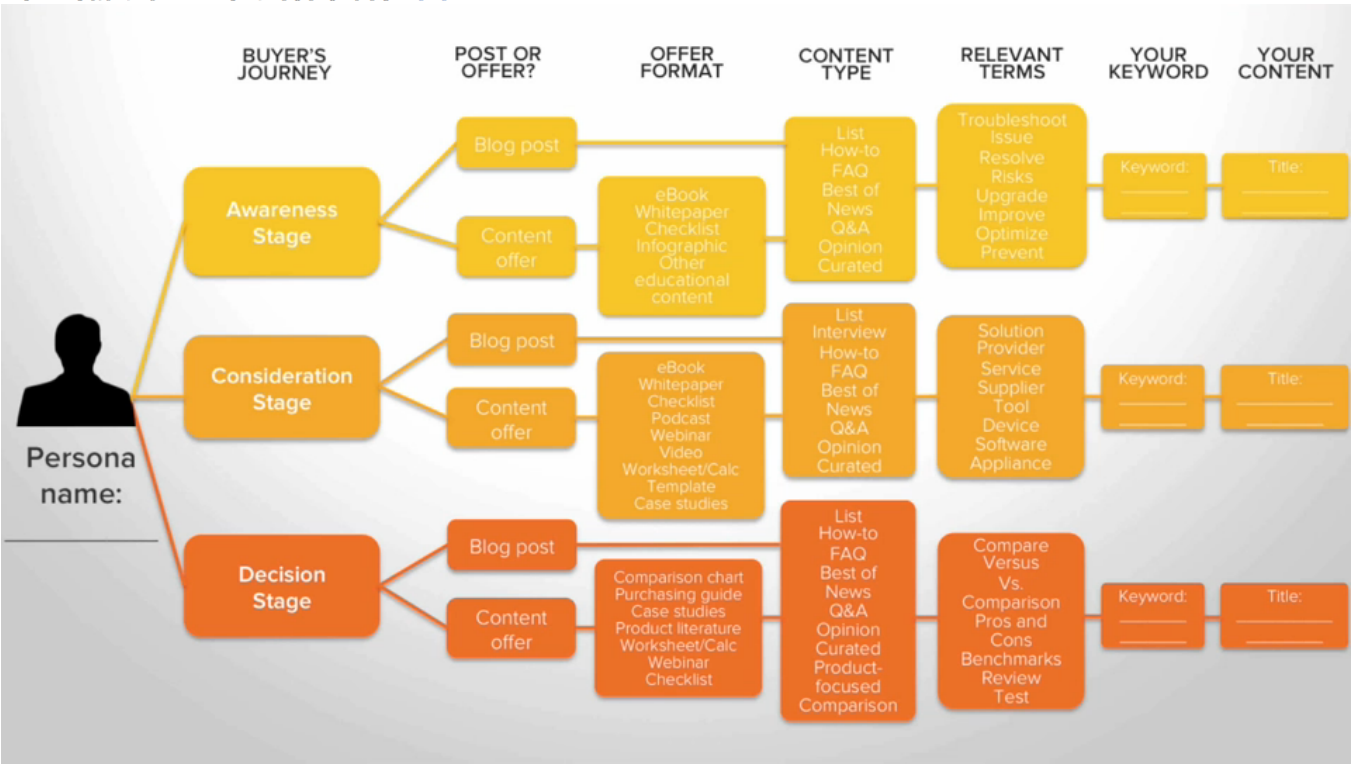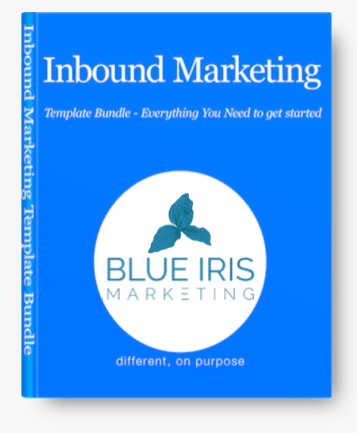The Buyer’s Journey: What is the Awareness Phase

Three Most Popular Plugins Easily Hacked
October 19, 2016
What is a Landing Page
October 26, 2016What is the Awareness Phase?
The Awareness Phase is the first of the four phases of the Buyer’s Journey.
A buyer who is in the awareness phase has a symptom or a need that needs to be resolved. They may not know what is needed to resolve or satisfy it. They likely don’t know enough about the need, problem or opportunity to actually name it (at this point). Their research for a solution consists of using phrases that describe their symptoms, the pain or the state of relief or resolve they are wanting.
The fact that this phase could also represent an opportunity to your buyer, is little spoken of. If you are B2B company and your ideal client has grown enough to benefit from your solution, they are having symptoms. You need to be able to name them. If your prospect has experienced business growth and your solution helps them grow to the next level or provides a competitive advantage for them, you’ll need to know the symptoms they are experiencing so you can create content that resonates with them at this phase.

When your buyer is in the first stage of their buyer’s journey, they are searching to understand the negative symptoms they are experiencing. These prospects have a problem that needs to be solved. Buyers in this phase aren’t completely sure what it is. Your buyer is querying the search engines for:
- Symptoms that match what they are experiencing
- Greater understanding of the problem
- The name of the problem
- The kinds of solution options that exist

Content that Resonates and Attracts Your Buyer
You can no longer ignore the way buyers are buying or the way they conduct their research prior to making their buying decision. That’s why it is so important to understand the decision path they travel before purchasing. The old, tired, traditional way of selling simply doesn’t work any longer.
I don’t know about you, but I’m happy for this.
Yes, creating content is time consuming. But, creating really good content that speaks directly to our buyers (whom we know and understand best), is how they want to be served. Building a strong and effective inbound marketing campaign has the potential to outsell your most successful sales person.
Quite frankly, developing a sound inbound marketing strategy that reaches all of your buyer personas right where they are, will outperform the highest performing sales person in your industry!
Ready to develop content that speaks to your awareness phase buyer persona? Let’s get started.
To help you maintain your content development momentum, we’ve written detailed how-to articles for developing content in each phase of the buyer’s journey. We’ve also provided you with all the templates you’ll need to produce the best results.
Click to and save these articles so you can finish your Buyer’s Phase for each persona.
How to Create Great Content for the:
To help you with every element of your inbound marketing campaign, we’ve written exhaustively about:
- Developing detailed buyer personas
- Creating content that attracts your buyer at every stage of the buyer’s journey
- Conducting a Content Audit and leveraging all of your content to create a cohesive content strategy
Your goal is to appeal to your targeted buyer, no matter what stage of the buyer’s journey they are in. To do that, you’ll have to understand each of the buyer personas you serve and what they are looking for at each phase of their unique buyer’s journey.
When a targeted buyer visits your website, they could be in any one of the phases. If you have high-value, well-optimized content that addresses your buyer persona’s needs in each phase, you’ll do well in the search engines when your keyword phrases are searched. If your on-page SEO is completed effectively, you’ll enjoy great click-through rates to your landing pages.
Getting Started – Developing Detailed Buyer Personas
Buyer’s Persona and Buyer’s Journey Templates. The success of your inbound marketing campaigns is dependent on knowing and leveraging accurate details about your buying persona. It is important that you have completed detailed buyer personas for each of your buyer persona types.
If you haven’t yet completed detailed buyer personas, I’ve provided a comprehensive buyer persona guide and detailed templates to help you.
To create magnetizing content for the awareness phase of the buyer’s journey, you’ll want to have your completed buyer persona templates handy.
With your buyer personas detailed and defined, you are able to begin mapping the journey they take as they navigate their way to resolving their pain and making a buying decision. I’ve also provided a free buyer’s journey guide and templates.
These guides and templates are highly detailed and refined – they are the same tools we use with our clients. We want to take all the guesswork out of this process for you.
Understanding the Awareness Phase in Context
Awareness Phase. Everyone starts in this phase. But not every buyer that comes to your website is in this phase.
This is the stage in which the buyer persona gains a greater awareness of their problem. They are experiencing pain, challenge or even an opportunity they haven’t experienced before. They have realized that something isn’t right or that they’ve attained a level of growth, success or opportunity that creates the need for a solution. Their goal is to better understand their symptoms, the problem and their solution options.
In this phase, your buyer is gaining an understanding of their condition and the context of their condition.
Consideration Phase. Consideration phase buyers have diagnosed, labeled and come to some level of understanding of their issue. They begin actively searching for viable solutions to solve the problem.
Decision Phase. Buyers who have reached the decision phase have determined what solution they need. They are now looking for a vendor or provider of the solution. It is in the decision phase that they begin comparing solution providers and pricing.
Delight Phase. The delight phase starts from the moment a visitor lands on your website or landing page for the first time. Your job is to delight them at every phase… answer questions they didn’t know they had and provide easy access to resources they need throughout the buyer’s journey.
Additionally, once a buyer has converted into your client, you’ll want to continue delighting them. There are a lot of considerations and opportunities to delight your buyers in ways no one else is.
This is good for your brand and your business. Delighting your visitors, leads and customers will result in social shares, brand awareness and referrals.

Understanding the Awareness Phase Buyer’s Mindset. To market effectively to awareness phase prospects, you will need to understand their mindset. Understanding what their pain, symptoms, opportunities and thought strings are will help you develop content that performs well in the search engines, and attracts and resonates with them.
With your buyer personas developed and as you begin mapping the buyer’s journey, you’ll gain insight and clarity around the thought processes of your buyer.
How to Identify High-Performance Keywords
Define keywords before developing content. Doing your keyword research is very important. In fact, you should have your keyword list for each phase of the buyer’s journey before you begin creating content. Your keywords, which are inspired by your understanding of the buyer’s thought processes, what they are experiencing and their symptoms will dictate the content you will develop in this phase.
Don’t put the cart before the horse or you’ll be wasting a lot of time and resources. Your inbound marketing campaign will be a flop.
The content you develop must be driven by:
- The symptoms your buyer is experiencing
- Descriptions of their frustration and their current condition
- Your buyer persona’s thought processes
- The variations in which they would describe all of the above
Long-tail Keyword Phrases Emerge From Your Buyer’s Thoughts. This is one of the first elements you’ll work on in the Buyer’s Journey template.
To gain a palpable understanding of your buyer’s condition, symptoms and experiences, you’ll have to put your feet in their shoes. At this phase, they are concerned, frustrated, and anxious to understand what is required to resolve the problem. An evolved buyer persona likely recognizes there is a lot they don’t know, they don’t know. That thought alone creates a great deal of anxiousness.
Your buyer’s awareness-phase thoughts result in the search phrases they will use.

Nailing the perfect search phrases. To help you identify the potential search phrases your awareness phase buyer persona is likely to use, consider these questions.
Leveraging your recent experiences with existing customers, let’s create your first list of perfect search phrases.
Create and list your answers in a document entitled “Awareness Phase Keyword Phrases.”
- What questions did they have before they fully understood what their problem was?
- What symptoms did they have and what kind of inconveniences and frustrations were they experiencing?
- What questions emerged from those experiences and frustrations?
- How was this problem affecting their day to day business?
- What interruptions and financial impact was occurring?
Taking your keyword phrases list to the next level. Remember I said earlier that your buyer will query the very symptoms they are having. They are going to use multi-word phrases. They will often query a long-string question. The question will often be those they are struggling with. It may be their very symptoms, too.
Let’s look at this short list of starter questions to develop long-tail keyword phrases your buyer might query. You’ll want to personalize each long-tail phrase for your industry, your product and your buyer’s needs.
Channeling your buyer’s thoughts, feelings, emotions, fears and needs. Imagine you are in your buyer persona’s awareness-phase condition. As the buyer, you don’t understand the problem. You are not likely to have a clue about how to find the solution because you haven’t diagnosed the cause or put a name to the problem. You may have never experienced this before.
As the buyer, what long-tail questions or phrases would you pop into your search engine browser to begin finding the content resources that will lead you to answers you need? Use these questions to help you identify your prospects thought process.
List your answers on your keyword phrase document. Where I have a “____,” you’ll want to create a search phrase for each symptom the buyer is experiencing. For instance, you could have numerous “How do I improve ____?” because you’ll have one for every symptom the buyer is experiencing.
- How do I improve ____?
- What is the best resolution for ____?
- How do I diagnose ____?
- Where do I troubleshoot the symptoms?
- How to questions that help identify the problem, the cost of the problem, the value of the resolution?
- When should I upgrade my existing solution?
- What options or resolutions exist to resolve my symptoms, pain or maximize opportunities?
- Where do the resources exist to help me learn about my situation?
It is within these thoughts that you will find your keyword phrases and terms. Understanding the thoughts that keep them awake at night and plague their mind all day will help you develop effective long-tail keywords.
We could write for months about the many methods to identify the perfect keywords and long-tail keywords and how to conduct comprehensive keyword research, but we’ll resist. In this article, we’ll focus on how to begin developing effective keywords and phrases for the Awareness Phase buyer.
Buyers in the awareness phase are evaluating every aspect connected to their challenge or opportunity. Use these keyword phrases and questions to drive content creation. These will help you create content that directly speaks to your buyer’s condition and content that will help move them closer to a resolution.
This is your opportunity to provide answers and value for them and develop a relationship that results in new business.

The Next Level of High-Performing Keyword and Phrase Development. Your optimized keywords should reflect your buyer’s thoughts. Keep in mind, “issue” or “opportunity” themed keywords will be used by awareness phase buyers in pursuit of a greater understanding of their challenge.
In addition to analyzing their thoughts, try paring the examples below with relevant industry terms to generate additional high-value keyword phrases. Add these to your Keyword Phrase document.
- Troubleshoot
- Issue(s)
- Resolve
- Upgrade
- Prevent
- Optimize
- Maximize
- Cure
- Eliminate
With this comprehensive list of precise keywords and long-tail keyword phrases, you are equipped with the framework you need to develop high-quality, highly relevant content that will rank well in the search engines. When your prospect begins searching for these terms, your well-optimized content will achieve high SERPS (search engine page results).
Keyword Phrase Performance Tip – How to Refine Your Keyword List. One last set of keyword and SEO tips before we go to the next phase. You don’t have to be an SEO expert or keyword specialist to find out which of your phrases have the highest potential to perform well in the search engines. With this simple process, we can prioritize them for use based on highest potential to perform. If you have more sophisticated keyword tools at your disposal, by all means use those, too!
Here are two tools I love and depend on when I’m doing keyword research.
- SEOquake. One of the tools I love is a free Google Chrome extension. It provides important data about each search engine results (SERPs). SEOquake provides important data about each search result. When I conduct a search, I look at the website’s rankings and determine if it is the best source for my information.
- Mozbar. Another tool I can’t imagine living without is Moz.com’s Mozbar. This is another all-in-one SEO toolbar for research on the go. It provides important metrics that help me determine the value of the search engine results I am conducting. SEOQuake and Mozbar provide on site detail information that helps me understand important SEO data.
The data that will be useful to you in this exercise is:
-
- Website domain and page authority – when you plug in a long-tail search query you’ll want to know if the top ranking results come from high-value websites. If there aren’t very many results and they come from low-ranking sites, you’ll know that it likely isn’t a frequently searched keyword phrase.
-
- Competitor’s keyword phrases – you can go to your competitors’ sites and use these tools to identify keywords they are using and what SEO techniques they are leveraging for success
Google provides powerful tools to help us succeed online. Here are two simple ways to refine your keyword phrase list so that you can capitalize on the best performing long-tail keyword phrases.
- Google Suggest. SearchEngineLand.com’s Aaron Wall outlines in greater detail how to use this free feature. As you begin to type out your search phrase, you’ll notice that a drop down list of suggested search terms appears. These are terms that others are using to conduct (sometimes) similar searches.
Once you’ve queried a search phrase, take a peak at the top of the results page to see how many results there are for that keyword phrase. Notate this number next to each phrase on your Keyword Phrase document. Keyword phrases with the lowest number of results (comparatively) may not be worth creating a lot of content for.
- Related Searches. At the bottom of Google’s search results page, you will find a section called, “Searches related to google suggests.” Take a look at these search phrase recommendations and see if they are worth using or replacing your original long-tail keyword.
Conduct a search for each keyword phrase. Prioritize your Keyword Phrase document so that the highest performing keyword phrases are driving your content development. Use them often and be sure to place them strategically throughout your website content.
To facilitate the highest page ranks for your content, you’ll need to place your keyword phrases strategically.

Getting the Highest Page Rankings – Where to Place Your Keywords and Phrases
Your new Keyword Phrase document contains all the keyword phrases your awareness phase buyer will use in search engines to find their answers.
Place them appropriately and frequently throughout your content (without stuffing) to create a natural flow; you don’t want their placement to appear forced.
For SEO purposes, place keywords within your:
- Offer Title
- Landing Page Copy
- Call to Action and the CTA Button
- Email Copy
- Email Subject Line
- Page URL
What Types of Content are Awareness Phase Buyers Seeking?
List of Symptoms. Your awareness phase buyers know they’re experiencing a problem. They are querying the symptoms that resonate with those they are experiencing. What they don’t understand at this phase may be the breadth of the consequences or the cumulative cost of the condition. They may not understand what other areas of their business is being affected or how severe the condition could be come.
You’ll attract them to your site with content that lists their symptoms. You’ll help them and inspire trust as you help them understand the full impact of their condition or opportunity.
Detailed Descriptions of Issues. Create content that lists and details the issues they are experiencing and those that will continue to evolve if the situation is unresolved. Most importantly you’ll need to create content that contains what they do know because they are searching for what they know. They will be querying their symptoms in the search engines. If you create highly relevant, high-quality content that is optimized well, you will enjoy high click-through rates.
Content that reflects their current position and provides insight into the problem will perform well.
Industry Specific Information and Data. Provide lists, ebooks, white papers and content that offers current research, results and data about their circumstances. Provide content that speaks both to their current pain and symptoms, as well as content that speaks to options and outcomes others have achieved as a result of eliminating the problem. This kind of content will help them transition to the consideration phase.
Buyers in the awareness phase want answers. They are looking for insightful information that points to a conclusion and relief.

What Web Pages Do Awareness Phase Buyers Visit?
Buyers in this phase are looking for educational content. They aren’t looking for a sales pitch.
Your blog posts are thoroughly reviewed by awareness phase buyers. They should include links to other helpful articles and downloads. Your goal is to build a reputation as the ‘industry expert.”
How-to or descriptive articles. Buyers in the awareness phase are looking for high-integrity content to help them diagnose their condition. Provide them information, written at a level anyone can understand, that helps them draw accurate conclusions so that they can continue their buyer’s journey and ultimately come to a decision that provides exactly what they need.
Social media platforms will help your awareness phase prospects identify with others that have experienced the same concerns. This provides the opportunity for them to connect with others who could offer advice.
As an industry expert, you have your buyer’s best interest in mind. Your content and abundant, high-value resources should convince them of that. Nurture your awareness-phase leads through their buyer’s journey by providing them the information they need at every decision phase. You’ll find the process of converting them from visitor, to lead, to customer will get easier as you begin developing and implementing the proper content and processes.
What is the Best Format for the Awareness Phase Content?
Buyers in the awareness phase need highly-trustworthy content that is easy to consume and provides answers. Appeal to their logic using data and facts. Consider creating content in the following format:
- Educational webinars
- Research reports
- White papers
- Ebooks
Not sure you have an offer tailored to an awareness phase buyer? Not a problem. Use our detailed content audit tool, you’ll be able to analyze, audit and identify your company’s most effective content. Conducting a content audit will help you categorize and refine your existing content so that you can leverage it more effectively, and attract and serve buyers in every phase.

How Do I Leverage Existing Content?
Inventory all content. Conducting a content inventory will help you label content according to the phase of the buyer’s journey it addresses. You’ll also be able to identify the specific buyer persona each piece of content speaks to. We’ve written a comprehensive “How-to Do A Content Audit” guide for you.
Edit or delete vague verbiage. Awareness phase buyers respond to clear, easy to read content. Eliminate content that does deliver value to this stage buyer.
Update research. Data and trends change at lightning speed. Be sure to continually refresh content with current data, studies, and facts.
Organize information. Organize content so that it flows in a sensible, consistent order of discovery. Create a step-by-step content outline and nurture your prospect through the process. Make all next steps obvious. Use email nurturing sequences to continually nudge your prospects through the marketing funnel.
Refine or update landing pages. The most important marketing tool at your disposal are your company’s conversion-focused landing pages. These are pages to which your buyer will be directed after clicking a link that promises a download, free or discounted offer.
The goal is to provide high-value content your buyer needs to help them identify their problem and make decisions. People are bombarded with offers and requests for their email addresses and personal information. Your content must provide quality, high-impact information in order to convince your prospect to provide you with their personal contact information.
The less information you request in exchange for your offer, the greater your chances of creating conversions.
What Elements Should Appear On the Landing Pages?
Keep in mind, you’re creating content for a specific buyer persona, in the awareness phase.
Offer. The offer should be in a format that is most attractive to awareness phase leads. Create a beautiful three-dimensional image that makes your offer aesthetically attractive. Use emotionally compelling, value-impact titles and sub-titles for your offer.
Explanatory Paragraph. Provide a succinct, outcome and value-based, convincing introductory paragraph that makes it hard to refuse your offer.
Bulleted Statements. Again, provide succinct, outcome-based, return-on-time-invested bullet statements. These are the key points that should compel your buyer to download or request your offer.
CTA Button. The CTA is your “call to action.” Your call-to-action should be compelling. It should inspire action – right now. Below that, you should have a CTA button or a beautiful and compelling graphic image that promises the outcome delivered by the content. Don’t waste the valuable content real estate on that CTA button with text that says something like, “SUBMIT.” If the content or download you are providing solves a specific problem, put that text on the button – “Click to Resolve X Right Now.”
Form Fields. The form fields capture your lead’s information and store it in your CRM to support your continued marketing efforts. In the awareness phase, you should request as little information from your visitor or lead, as possible. It is recommended that you only ask for their email address.
If having their first name and their email address provides a significant value to you, is needed to provide their offer effectively, or if the value of your offer is so significant that it warrants more than your prospects email address, then you may be inclined to ask for both. The goal at this phase is to acquire their email address so that you can begin nurturing them through the buyer’s journey. If asking for their name reduces conversions, don’t do it!
As you build loyalty with them, they will gladly provide a reasonable exchange of information as trust and the value of your offers increase.

How do I nurture an awareness phase buyer through the rest of their buyer’s journey?
Understand that your buyers in the awareness phase are most likely overwhelmed. Use natural (not forceful or aggressive) nurturing strategies to move them forward. Done well, your prospects will appreciate your educational efforts. Your nurturing processes could be your strategic advantage over a competitor.
Define and follow a process that will continue to nurture your buyer.
- Create trust. Assure your buyers you are prepared to guide them through their entire journey. They might need a little reassurance. Remind them you have their best interest in mind and you are there to help them get their questions answered and their problems solved.
- Create a reputation. Send prospects case studies, research, or any other high-value information that is helpful to them in the present. New facts may influence their decision to continue their journey.
- Create a follow–up plan. Continued relevant communication is key. Through constant email and phone contact, you maintain a relationship. Your buyer will feel far more comfortable accepting your call or reaching out to you compared to other businesses with whom they have established less rapport.
Download Your Templates – Immediate Download
Download all the templates you will need to create high-performance content for every stage of the buyer’s journey. We’ve combined all of your templates in one place.
Need help? Connect with me via Facebook,Twitter,Email, or even the old fashion way – give me a call.





